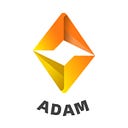Blockchain Application of ADAM in data encryption and computing network
As the first data encryption and computing network based on web3.0 , ADAM takes the lead in solving the problems of data transmission, storage, sharing, traceability and confirmation of rights on the chain. Among them, blockchain technology will inevitably be widely used, because the block chain system can provide a trusted infrastructure between distrusting parties. However, the method of directly uploading the original shared data to the chain is not suitable for large-scale data sharing scenarios. Therefore, ADAM proposes a data sharing platform architecture with data sharing request and response records on-chain and secure transmission of original data off-chain. This architecture can alleviate problems such as system overload and privacy protection to a certain extent.
In order to ensure the overall security and efficiency of the data encryption and computing network, ADAM needs to prevent fake or malicious nodes from tampering with data. Each network node of ADAM stores a complete copy of the data and uploads all shared data to the chain, which breaks the upper limit of the storage capacity of a single node and builds a vast data sharing ecosystem. All nodes participating in the ecology can not only transmit data information, but also receive and store data information. After the information is signed by the operator, it is spread in the P2P network. The final information is packaged into blocks in batches by the master node determined by the consensus protocol, and continues to pass through P2P The network is propagated to other verification nodes. After the verification node confirms that there is no error, the local bookkeeping is in units of blocks, and the blocks are connected by cryptographic hash pointers. In this way, each node can save a complete blockchain data.
This kind of data is signed and packaged into blocks in batches, and the blocks are additionally stored in the form of hash chains, and finally the data storage mode distributed by full replication ensures that the data information is difficult to tamper with and traceable. In most current blockchain systems (such as Ethereum and Hyperledger Fabric), only cryptographic signatures are used to prevent data from being tampered with, and the content is still stored in plaintext, which can be seen by all participants, However, this method of data sharing that relies on blockchain brings the risk of privacy leakage.
In addition, in view of the independent status quo among the public chain ecosystems, it is difficult and costly to share data on the chain, thus forming data islands, This directly leads to the inability of the value of the data on the chain to be used as it should be, resulting in a great waste of data resources. As a natural transcendental application, ADAM can give full play to the greater value of data by breaking data silos and realizing data sharing. Data confirmation is the key to the value of data, which includes confirmation of data ownership and use rights. Among them, the ownership can be an individual (such as a private data owner) or an institution (data provider), and both can be traded, or transferred and granted through laws and regulations.
With the increase of participating nodes in the ADAM network and the increase in the number of responses to data sharing requests that need to be processed per second, when applying the existing blockchain technology to the field of data sharing and confirmation, efforts still need to be made in the following four aspects: firstly , design an efficient verifiable and recoverable data scalable storage method; secondly, on the premise that all nodes can participate in the consensus process fairly and equitably, improve the efficiency of the deterministic consensus protocol and ensure the security of the protocol and activity; thirdly, effectively utilize the characteristics of blockchain smart contracts to improve the efficiency of concurrent execution of smart contracts; finally, with the goal of reducing network overhead and computational cost, a verification structure and an efficient verification query algorithm are designed to respond to PC end query.
When ADAM applies blockchain technology to the field of data sharing and right confirmation, it challenges and proposes improvement directions in distributed storage, consensus protocol, smart contract execution and PC query, Point out technical bottlenecks that need to be further broken through for the application of existing blockchain systems in the field of data sharing.
